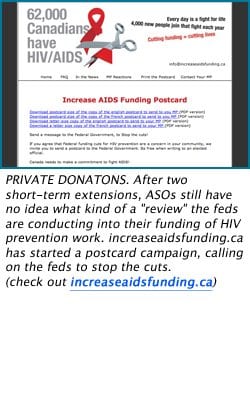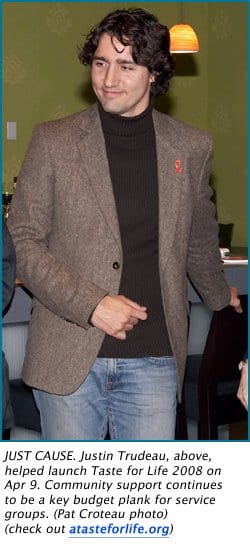“It’s like constantly wondering, ‘What are we going to do?'” says John McTavish from Kingston, speaking about planning AIDS prevention programs. “You wonder, ‘what’s next?’ You’re always trying to think ahead, to what we should be doing in the future.”
But that’s just gotten a lot more complicated, says McTavish, the director of HIV/AIDS Regional Services for Kingston (HARS). He doesn’t know what AIDS programming will be available to residents there a year from now.
That’s because service groups across the country are being kept in the dark about what the federal government’s contribution to their programming will look like past March 2009.
HARS has two part-time employees working on HIV prevention and education, both sponsored by the feds. They give out important health information to high-risk youth, the gay community, and others.
“It’s hard to keep your staff and for them to want to commit,” says McTavish. “Stress level goes up — for not just of those staff, but for all the staff. So you have turnover, and then you have to begin all over again.”
Brian Lester agrees. He heads up prevention work at the AIDS Committee of London. There, the federal programming pays for one full-time employee to run education campaigns in bathhouses, bars and in gay chatrooms online.
“That money helped us dedicate resources to the gay-bi-MSM community,” says Lester. “We would lose our capacity to do the extensive outreach we do.”
In Canada, the provinces typically pay for AIDS groups’ core funding. The community, through fundraising, pays for most of the service delivery. The feds kick in for HIV prevention, education and some support work.
Or they have, historically.
There are less than 11 months of federal AIDS cash remaining. Last month, the clock ran out on federal funding for hepatitis C work. It has yet to be replaced.
It serves as a chilling precedent. It also means that AIDS groups, which often provide hep C programming, are already feeling the pinch.
HARS received federal hep C money “off and on” over the last five years. It has always been “piecemeal,” says McTavish.
“We have people living with hep C coming through our office every week. Especially when it comes to services, we don’t want to say, ‘No we can’t help you,'” he says.
And in Kingston, “we don’t have anywhere else to send them,” says McTavish.
“We may have been the only game in town for hep C,” he says. “Whereas in larger urban centres, there may have been other people doing the work or a little bit of the work.”
McTavish may see hep C money again. But that uncertainty makes planning difficult. Elsewhere, groups like the Toronto-based Africans in Partnership Against AIDS still haven’t heard if money is coming in between now and March 2009.
“We submitted a request and are still waiting for a response,” says Fanta Ongoiba, the program’s director, in an email to Capital Xtra. “I know that some agencies have already received their approval letter and some not yet. So we don’t know if it has been approved or not.”
Historically, funding has been issued in four-year blocks. But since the Conservative Party took the helm, they have simply extended existing funding in six-month and one-year increments. The result is perpetual uncertainty for groups that receive funding — and no opportunity for new groups to apply.
The problems are magnified for AIDS Service Organizations (ASOs) in areas that are rapidly growing. Durham Region is growing by 10 percent every five years. It’s home to some of Ontario’s quickest expansion — between 2001 and 2006, the city of Whitby grew by over 27 percent. Some estimates suggest Durham region will double in population by 2020.
AIDS Durham has been shut out of federal funding since 2000. Peter Richtig is the director.
“That’s part of the problem,” says Richtig. “But there’s never been an adequate pool of money for AIDS organizations, so it’s incredibly competitive. Emerging agencies don’t have that kind of staff and they don’t have the capacity to jump through all the hoops.”
“We’re the only people providing unconditional support, and we’re out panhandling in the community when we should be in the office with clients,” he says.
It’s an even more bitter pill to swallow because the envelope was supposed to get bigger in 2007, not smaller. For Ontario, $1 million in promised additional federal funding was yanked in 2007, with a further $1 million of promised money gone for 2008-2009. By 2012, the federal funding envelope will be $7 million smaller.
Murray Jose is from PWA Toronto. Like in Kingston, PWA Toronto’s federal money runs out next March.
“Many organizations that were not successful in the last grant application round have had no opportunity to re apply and get federal funding — so there is huge disparity between ASOs,” says Jose.
“We would have applied and been able to create new programs or adjust our work to most effectively respond to changing needs of our clients.”
As for the Public Health Agency of Canada (PHAC), they’re keeping their cards close to their chest. On hep C funding, they’ve committed to renewing their contributions later this year. But they’re silent about community AIDS programming.
“We continue to work with community organizations that make a positive impact on addressing the hepatitis C epidemic in Canada, and we look forward to supporting more community projects on a national and regional scale,” says PHAC’s Phillipe Brideau in a written statement to Capital Xtra.
He says that in 2007-08, the “main focus” of hep C spending was on “strategic planning,” including meetings with service providers across the country.
“We are anticipating announcing our planned approach in the coming weeks,” he continues. “We realize that community organizations have been waiting for some time to hear news of federal funding, and we are optimistic that our renewed approach will provide our partners with the support they need.”
But with AIDS funding, they won’t even say what the shape of the review looks like.
“As for the overall Grants and Contributions fiscal review, final decisions have not yet been made on the budget levels,” he writes.
Groups in Ontario, Quebec and Alberta are fighting back. Last month, the Ontario AIDS Network started a postcard campaign, calling on the Conservative government to restore funding to promised levels.
They’ve also launched a national website, increasedaidsfunding.ca.
The message to politicians is that cash promised in 2005 needs to be delivered, says Rick Kennedy, director of the Ontario AIDS Network.
That would mean increasing federal contributions to ASOs to $13.9 million in Canada, or $4.5 million for Ontario.
“They’ve never said that the money is not necessary or not needed,” says Kennedy. “They’ve only said that they can’t afford it because of across-the-board cuts to PHAC. We’re left wondering where their leadership is on this.”
The frontline workers agree.
“We’re concerned overall with the direction that this government,” says Lester from AIDS Committee of London. “It’s about commitment to the issue.”



 Why you can trust Xtra
Why you can trust Xtra


